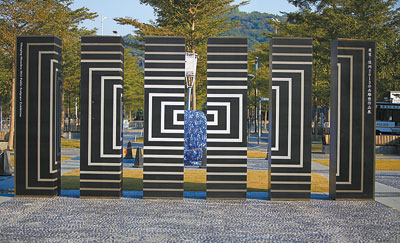
Anna Zhao
anna.whizh@yahoo.com
THE first Shenzhen public sculpture exhibition on the open square of Shenzhen Book City CBD Store includes the works of 12 artists, and is an exploration of the relationship between public art and urban spaces and how public art serves urban dwellers.
With a theme of qualitative change resulting from public sculptures, the exhibits cover a wide scope of topics with creations using different materials, ranging from wood to nature and recycled electronic chips.
Most of the exhibits go beyond people’s understanding of conventional sculptures with their choice of materials allusive to their intentions.
South Korean visual artist Kim Soo-nim’s “Nanun Dol: Space 59 — Shenzhen 2013” uses silk threads to bind feathers and stones to strings suspended in air. Kim said the stones, which she collected in Shenzhen’s beaches, symbolize the city’s history and natural development. “What I’m describing is ‘I’m a dancing stone in the wind.’ I use feathers and stones to respectively represent lightness and weight and they can form a different combination in balance with the use of thread. I intend to make people see the world another way through my work,” Kim said.
“Growing From Shenzhen” by Chung Hye-ryung, also from South Korea, is a pair of dead tree trunks looking at each other with hand-shaped wires at the tips of the trees. The artist said the two tree trunks, with space between them to indicate separation, can be united with visitors moving around the two items. Chung, who often uses abandoned items, said she wants to rekindle people’s emotions for the objects they had once abandoned.
Shenzhen artist Yang Guang’s “Another View” uses scrapped electronic chips, a common material used in Shenzhen’s electronic manufacturing industry, as tree bark. Dai Yun’s “Cruise,” a brick structure, is a mutated mixture of whale and ship with a chimney.
Many artists use surrealist expression to show their concern for the problems that have surfaced in the process of urbanization, such as environmental pollution and animal protection.
“Shenzhen Climate Exchange” by Wang Mai associates air pollution and climate change by using the installation of an automobile and meteorological observation boxes. The automobile is covered by a camouflage-colored cape to indicate man-made nature.
Zhang Kaiqin’s work “Black-faced Spoonbill” uses wires to draw the silhouette of a local bird species that is dwindling in numbers. The barely visible body of the black-faced spoonbill foreshadows the fate of the endangered species that migrate in the winter at Shenzhen Bay, the world’s second-largest habitat for the bird.
Exhibition curator Shu Yang said Chinese mainland artists are increasingly aware of their own cultural heritage and making innovations in their work to embody their native experience.
Huang Rui’s work “All for One and One for All” is a group of four three-dimensional Chinese characters that combine to give two contrary but interrelated interpretations when read in reverse orders.
In “Rising Peaks,” artist Zhang Wei carves out a three-dimensional traditional Chinese ink landscape scroll painting on several layers of steel board.
Liu Chunyao’s “Multicolored” uses polished stainless steel to catch the scene of a child blowing bubbles. Instead of using different colors, the artist uses different shapes of bubbles to express his emotional changes.
Different from rare pieces treasured in museums, artists of public sculptures are paying more attention to the public’s interactive experience with their works. “Aware” by Dong Shubing is a subtle portrayal of a crying baby that has freshly awaken from a sleep. The enlarged body of the baby, made of steel blocks pieced together, allows intimate touch and children can mount onto its body just like playing with giant toys.
“Genesis” by Ren Rong is a collection of plant and animal images carved out of steel, which is reminiscent of traditional Chinese folk paper-cutting. Visitors can knock on the sculpture with steel hammers hanging on it and listen to the different resonances.
Shu said that despite the small number of exhibits, the exhibition is showcasing changes from multiple perspectives. “Sculpture art creation is a continuous process of progress with artists’ cognition of the world, for example, the relationship between art and urban spaces, art and a particular city,” Shu said. “The diverse styles and elaborated artistic expressions showcasing in this exhibition herald an era in which artists are making real changes to urban spaces.”
Shenzhen Public Art Center said the exhibition is also inviting the public’s opinions and votes on the exhibits to decide which of them can permanently stay in Shenzhen.
Luo Xiaoping, director of the public art department of Shanghai Institute of Design, said in a seminar during the exhibition that public art should be integrating extensive public interaction, rather than an artist’s individual undertaking inside his art studios. “A big challenge with contemporary public art is how to make it related to ordinary people’s lives and fit into urban environments and spaces to resonate with its spectators,” Luo said.
Dates: Until Jan. 27
Venue: West square of Shenzhen Book City CBD Store, Futian District (深圳中心书城西侧广场)
Metro: Longgang or Longhua Line, Children’s Palace Station (少年宫站), Exit C2 or D
|

